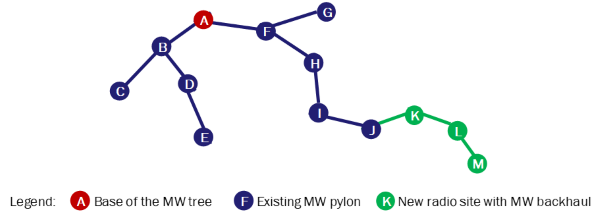New-generation mobile cost models: addressing broader issues beyond termination rates
30 April 2020 | Regulation and policy
Loïc Tchoukriel-Thébaud | Gilles Monniaux
Article | PDF (3 pages)
Over the past 20 years, national regulators have developed mobile cost models with one specific objective in mind: to set cost-oriented mobile termination rates (MTRs). However, Analysys Mason’s new mobile cost model, developed for the French regulator Autorité de régulation des communications électroniques, des postes et de la distribution de la presse (Arcep), demonstrates that such models have the potential to offer regulators worldwide a more-detailed understanding of the mobile networks that are active in their country.
Arcep commissioned the development of its new mobile cost model despite the imminent introduction of Eurorates1 (EU-wide fixed and mobile voice call termination rates) and the less-contentious regulatory debates about MTRs in the EU now that the ‘Pure LRIC’ MTRs are sufficiently low that they do not significantly constrain retail offers such as unlimited voice.
Talking to operators on an equal footing when it comes to the knowledge of network costs
This new generation of mobile cost models chiefly aims to understand the total cost of specific commercial or societal aims rather than to calculate the unit cost of a regulated service. In particular, Arcep wanted to understand the cost of:
- extending the coverage of a mobile operator
- upgrading radio sites’ backhaul technology to fibre
- offering a given throughput per site on all 4G sites with current spectrum allocations (with or without refarming from 3G)
- maintaining operators’ networks in their current state of deployment.
Arcep has used the model so far for the first (4G and/or 5G coverage) and fourth activities described above.
This new cost model complements the ‘regulation from data’ approach2 that Arcep has adopted since 2016, which offers end users of telecommunications services detailed information about the availability and quality of networks (both mobile and fixed) to inform their choices. The information provided partly relies on data collected from these same end users. Both approaches combine to provide better regulation, which helps to create an environment for, and stimulates investments in, high-quality networks. This, in turn, will have positive socio-economic externalities.
The new-generation cost model was produced with the co-operation of the French telecoms industry
French operators agreed to participate in the development of Analysys Mason’s mobile cost model by contributing detailed comments during several consultations. This means that the model more accurately reflects their current networks and is better placed to help Arcep to evaluate the cost implications of their evolution over time. The model also relies on extensive databases that store information about operators’ radio sites (these databases are, to a large extent, publicly available3) and databases about microwave backhaul links (which are held by Arcep, but bring together data submitted to it by the operators).
This bottom-up model was developed to calculate network costs in the following three modes.
- Analysys Mason used operators’ databases that hold information about radio sites and microwave backhaul links to replicate actual deployments. Cost results were calibrated against the regulatory accounts of each of the metropolitan4 operators.
- The hypothetical extension of an actual network was evaluated through the addition of new sites deployed in specific locations (which may have been determined via a radio-planning exercise), as shown in Figure 1.
- A testbed mode simulated the impact of new technologies that have yet to be deployed (for example, 5G, virtualised core and cloud RAN).
The first two modes apply to all existing operators in metropolitan France and the French départements d’outre-mer (DOM, grouped into those located in the Caribbean and those located in the Indian ocean). The third mode applies to all existing operators as well as to one hypothetical, generic operator in each area.
Figure 1: Analysys Mason’s mobile cost model extends the network by adding new sites and connecting them to the existing backhaul network (microwave (MW) links are shown in this example)

Source: Analysys Mason, 2020
Mobile cost modelling can provide better regulation
This new generation of mobile cost model can give regulators worldwide a detailed knowledge of the cost implications of future deployments to be borne by the mobile operators in their country. Analysys Mason has conducted almost 200 cost modelling projects over the past 10 years and, as a result, has acquired unrivalled experience in developing and updating cost models, often including consultation with various industry stakeholders. For further details about how Analysys Mason can support you with any of the issues outlined in this article, please contact Loïc Tchoukriel-Thébaud or Gilles Monniaux.
1 European Commission (11 December 2019), Summary report on the public consultation on voice call termination rates.
2 Arcep (16 January 2020). Available at https://www.arcep.fr/la-regulation/grands-dossiers-thematiques-transverses/la-regulation-par-la-data.html.
3 Agence Nationale des Fréquences (ANFR), L’observatoire en carte. Available at https://www.anfr.fr/gestion-des-frequences-sites/lobservatoire/lobservatoire-en-carte2/.
4 This includes operators in mainland France but excludes those in the départements d’outre-mer (DOM) and territoires d’outre-mer (TOM, such as French Polynesia, New Caledonia, and various other small French islands around the world with little or no population).
Article (PDF)
DownloadAuthors

Loïc Tchoukriel-Thébaud
Manager
Gilles Monniaux
PrincipalRelated items
Article
Policy makers must explore all possible levers to achieve gigabit connectivity ambitions
Report
AI for connectivity: how policy makers can help digitalisation
Report
LEO satellite broadband: a cost-effective option for rural areas of Europe

